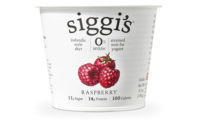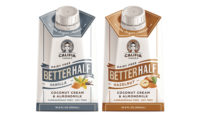
Hard News on Rigid Packaging
by Lynn Petrak
From traditional cartons to cutting-edge plastics,
dairy manufacturers can hardly contain their creativity.
If the dairy case was once
a sea of white, it’s certainly awash in color, pattern and shape
right now.
While flexible packaging may get the glamour in some
parts of the retail store, such as the cheese case, much of the
refrigerated dairy case is lined with rigid packaging that is increasingly
designed to stand out and be noticed. Indeed, the interpretation of the
term “rigid” as dull or stiff doesn’t apply to containers
that are constructed from cardboard, plastic, glass and aluminum, whether
they’re used for direct consumer sale or stored in foodservice
refrigerators and freezers.
Like any good package, some of the latest rigid
packaging designs for dairy stem from technical improvements to the
material itself. Other advances reflect purely aesthetic features, from
improved on-package printing to tamper proof or recloseable openings. Many
recent upgrades and new product introductions exemplify a bit of both.
Plastic’s Next Step
The flurry of plastic bottles and containers that have
emerged over the past decade certainly helped open the floodgates to
innovative rigid packaging design for dairy products. For all of the
eye-catching, strategically-developed single-serve milk bottles and jugs,
there have also been noteworthy advances in plastic vessels for cultured
products, dairy-based beverages and, to a smaller extent, ice cream.
On the material side, packaging suppliers have put
their own R&D teams to work on developing bottles and containers that
ensure quality and freshness while drawing attention in a crowded
marketplace.
From a structural standpoint, for instance, Amcor PET
Packaging, with U.S. offices in Manchester, Mich., recently announced a new
family of polyethylene terephthalate (PET) containers called the QuadPlus
and QuadMax3, which offer improved strength for hot-filled beverage
applications.
The QuadPlus is used for 46-, 48- and 64-ounce
hot-filled rectangular PET bottles. The QuadMax3 was designed for beverage applications currently in
round PET containers or already in a rectangular footprint but appealing
for processors interested in converting to 64-, 46- or 48-ounce rectangular
footprints with space-saving geometry.
Also in the PET category, in a case of what’s
old can be new, Union, N.J-based manufacturer O. Berk Co. has introduced a
new PET line of dairy rounds in five sizes, from 8-ounce to 32-ounce
containers. The bottles were designed to look like old fashioned milk
bottles with round bodies and tapered-style necks. The dairy rounds have an
option of labeling and frosting for visual effect.
Meanwhile, in another literal old-is-new development,
Minnetonka, Minn.-based NatureWorks LLC, a stand-alone company wholly owned
by Cargill, doubled its sales in the first half of 2005 compared to the
previous year, as interest in its renewable-resource-based packaging grew
dramatically. Currently, NatureWorks offers a resin derived entirely from
the sugar found in common field corn, or maize, as an alterative to
petroleum based PET. With oil prices skyrocketing, NatureWorks has been
working to promote its cost advantage.
In some notable cases, plastic is being used for dairy
products other than liquid beverages. Dreyer’s Grand Ice Cream Inc.
shook up the freezer in 2005 with plastic packaging for its new line of
Dibs bite-size ice cream novelties, which come in a bright red tub with a
tamper-proof recloseable lid.
Beyond the bottle, jug or tub itself, the advent of
sleeves certainly changed the visual impact of plastic bottles used for
dairy when they were broadly introduced into the beverage category in the
past 10 years or so. Bottle design these days continues to improve,
including sleeves and other printing technologies, resulting in packages
with greater clarity that “pop” from the shelf or case.
IPL Packaging, a Canadian designer and manufacturer of
innovative packaging based in Saint Damien, Quebec, now offers in-molding
labeling (IML) for plastic packaging in place of traditional dry-offset
printing. According to Stephane Auclair, marketing manager, IML technology
offers several advantages, such as full photographic quality, top-to-bottom
container coverage, 100 percent shading of colors and typefaces as small as
6 point. “Many people will appreciate the no label look. Because the
label itself is polypropylene, it becomes basically integrated into the
container,” he explains. “The greatest benefit is graphic
quality, because it has twice the resolution. It is also always at the
right position.”
Dairy applications for IPL’s new IML printing
include containers of specialty cheeses, such as cheese in brine and feta,
along with various dips. At this point, Auclair says, IPL doesn’t
specialize in liquid food packaging. “We are looking at yogurt, and
are in the R&D stage,” he adds.
Like suppliers of packaging materials, companies that
provide equipment for rigid packaging are also upgrading their offerings.
For processors looking to reach out to the global dairy market, for
example, Uniloy Milacron, Tecumseh, Mich., is supplying HDPE milk bottles
for countries with limited refrigeration systems. Uniloy recently
introduced a new reciprocating blow-molding machine that can produce
three-layer extended-shelf-life (ESL) bottles.
Uniloy’s new UMR2000-3L can produce 5,400
bottles an hour, which are typically topped with a foil seal and screw cap.
“Primary advantages over wheel and shuttle blow molding machines
include lower energy costs, shorter dry cycle time, lower melt temperature
and higher clamp force,” says Richard Smith, director of sales and
marketing, reciprocating technologies.
Other Packages
In addition to plastic, other rigid packages for dairy
are sporting a new look these days, to better entice buyers and maintain
product quality.
On the paper side, suppliers across the board offer an
array of packages with different finishes and closures, from gabletops with
screw caps to multi-layered cartons for aseptic beverages.
Swiss packaging manufacturer Elopak recently
introduced a sleek paper-based package called the iCone for premium
beverage products. The iCone features a unique cone shape and comes in a
range of sizes, including single-serve containers that fit into cup
holders. The large flat surface on the iCone’s front panel maximizes
brand exposure, and the packages have an environmental benefit in that they
require less of a thinner grade of paperboard.
Canton, N.C.-based Blue Ridge Paper Products Inc.,
meanwhile, has been working on new window cartons and expanding
applications of its DazzlePak, a holographic film laminated to a food-grade
paperboard substrate.
Finally, in the world of rigid packaging for beverages
and foods, aluminum is nothing new. What is different, though, is the use
of aluminum for shelf-stable dairy-based products. Indeed, many new
milk-based drinks are packaged in specialty cans that can withstand high
temperature processes required for shelf stability.
One example comes from Seattle beverage kingpin
Starbucks Coffee Co., which recently launched Starbucks Iced Coffee sold in
a can. Caffe Del Mar is another company that fills its coffee drinks in
aluminum, offering a 15-ounce canned espresso latte energy drink called
Frappio.
There has been other packaging news in the bustling
ready-to-drink coffee can segment, which indicates that while the market
for rigid packaging is dynamic, there are lessons to be learned. The
Wolfgang Puck brand licensed by WP Beverages developed a series of gourmet
coffee latte and mocha drinks sold in a unique self-heating can, which were
distributed broadly in Safeway and Albertsons supermarkets earlier this
year. Although the cans were reportedly nearly 10 years in the making, the
products were officially recalled from the market in the spring because
some cans began bursting, melting or not heating up the coffee
appropriately enough.
Lynn Petrak is a freelance journalist based in the
Chicago area.
$OMN_arttitle="Hard News on Rigid Packaging";?>
